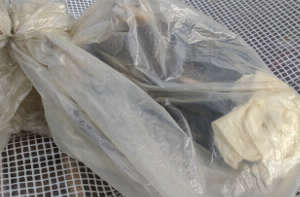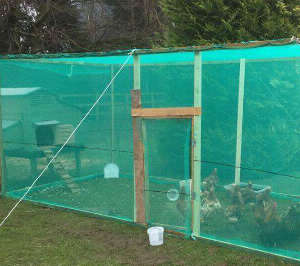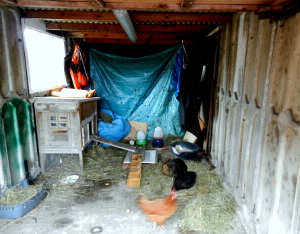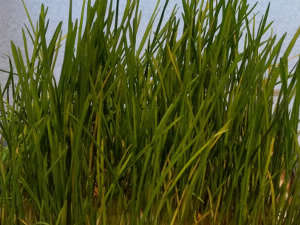By Neil Armitage Published on
Bird Flu FAQ and some practical advice for Avian Influenza.

How do you try to avoid the plague of bird flu?
Avian influenza viruses can be divided into highly pathogenic (HPAI) and low pathogenic (LPAI) strains based on its ability to cause disease in poultry. Low pathogenic avian influenza is a natural infection of waterfowl that may cause minimal to no signs of disease in domestic poultry and wild birds and is not a serious threat. Highly pathogenic strains like H5N8 causes severe disease in domestic poultry with a high death rate.
Influenza viruses are divided into sub-types based on the two proteins found on the surface, hemagglutinin (H) and neuraminidase (N).
There are 16 recognized H types, and 9 N types, and these are known to occur in a number of different combinations - the combination that is the cause for current concern in the UK is H5N8.
Only two types of avian influenza viruses, H5 and H7, are known to include highly pathogenic viruses. Not all H5 and H7 influenza viruses are highly pathogenic, but H5N1 and H5N8 are.
These forms may cause disease in chickens and some other species of birds that affects multiple internal organs and has a mortality rate that can reach 90-100 percent, often within 48 hours.
Unlike some diseases, avian influenza is not an air-borne disease. Most current evidence suggests that the virus spreads mainly through the movements of poultry, poultry products, people and the vehicles they use for transport. Live animal or 'wet' markets may have played a major part in sustaining the virus in Southeast Asia and there is also a huge international trade in poultry - both legal and illegal.
The legal trade involves millions of hatching eggs and poultry being shipped to destinations worldwide; information on the extent of the unregulated and illegal poultry trade is scarce but interceptions in recent years indicate lapses in border controls despite the risk. The widespread illegal trade in ornamental, sporting and caged birds has also transported infected birds over large distances.
Bird flu is controlled in the UK by Defra recognised zones:
1. The protection zone. This applies to an area 3 km around a confirmed case of avian influenza. It is the tightest control and prevents the movement of most animals and waste products unless seized by the inspectors. Table eggs are about the only thing that can be moved without a licence.
2. The surveillance zone. This is an area of 10km radius around an infected site. This area requires disinfection of vehicles and bio-security measures
3. The prevention zone. This is in place in the UK when birds may be allowed out in certain areas with some restrictions. It currently also bans poultry gatherings like shows and the release of birds like pheasants.
If you are inside a high risk area birds will only be allowed out in a fully covered or netted run.
Outside of higher risk areas and in addition, poultry keepers will have the option to allow birds outdoors into fenced areas provided the areas meet certain conditions:
1. The areas have been made unattractive to wild birds, for example ponds have been netted, wild bird food sources removed.
2. Action has been taken to reduce any existing contamination, such as cleansing and disinfecting concrete areas, wet/boggy areas are fenced off.
3. Assessments have been made of the risk of birds coming into contact with wild birds or contamination from them.
My take on reading the guidance is that birds cannot be free ranged , they still need to be contained in a designated and fenced area.
Your procedures are as important as the prevention measures, all the foot baths in the county aren’t going to help you if you local robin is sneaking into the run or rats and other vermin are roaming freely.
There is currently a legal obligation to house poultry if you have been ordered to do so or to minimise the contact with wild birds. Expect this restriction to return repeatedly, probably every year.
What are the symptoms of avian influenza in birds:
The first point to notice with bird flu is that is likely a large percentage of your birds will be ill at the same time or within 24 hours of each other.
Swollen head - Of varying degrees.

Purple comb and wattles – this is called cyanosis and refers to the blue that begins to permeate the red areas of the comb and wattles. It is an indication of breathing difficulties and/or heart failure. In bird flu it looks more like bruising than an even colour.

Discharge – From the eyes or nostrils
Panting or gaping – Struggling to breathe and craning the neck forward. Makes a rattling sound
Diarrhoea – loose or off colour (Green) stools.
Death - it may seem odd that death is listed as a symptom but Highly pathogenic bird flu like H5N8 kills fast and in great numbers. Sudden deaths of a large percentage of your flock
Infected birds shed flu virus in their saliva, nasal secretions, feathers and faeces (droppings). Susceptible birds become infected when they have contact with contaminated excretions or surfaces that are contaminated with excretions.
At present the only control is culling of infected flocks.
Bird Flu - the law and what you need to know.
Avian influenza is a notifiable disease - this means that you have to contact DEFRA if you suspect the disease and it is important to remember that ignorance of the law is not a defence. You are expected to keep your poultry within the law and to know what those laws are.
If a government vet turns up at you door and you say " I didn't know / realise " you are likely just to p*ss them off and could end up with a fine of £5000 or 3 months in jail.
FAQ about bird flu:- Questions I have received by through the website
Q1.So how many birds have bird flu?
Answer: A study in Indian sparrows and cordites found infection levels of between 0,36% or around 1 in 300 and 1.06% or 1 in 99 birds.
This study into tree sparrows in china - A Survey of Avian Influenza in Tree Sparrows in China in 2011 - found infection levels of 11.75%
Where waterfowl are involved living in infected ponds it could be anything between 1 and 25%.
So it depends on your area, season and the type of bird.
Q2. How is the disease spread?
Answer: It infects the gastric tract and is spread through the droppings. This is why waterfowl spread the virus so easily. The virus survives well in water and the way water fowl feed opens them up to infection.
It is important to mention at this point that most outbreaks of avian influenza can be linked to movements of poultry, poultry manure, poultry by-products and accidental transfer of infected material such as bird droppings, bedding straw or soil on vehicles, equipment, cages or egg flats, clothes and shoes.
Worldwide, unregulated movement of poultry is the most important way that the disease is spread.
Contrary to popular belief migratory birds are not a reservoir for bird flu.
Q3. How long does the virus remain viable (stable and infectious) in the environment?
Answer: It depends. The things that kill viruses are heat, UV light and desiccation or drying out. I have seen viability times quoted from 10 days to 21 days.The studies I have seen where it was actually measured was this one into the persistence of Avian influenza in infected domestic ducks. They discovered Viral infectivity persisted in the feathers for 160 days at 4°C and for 15 days at 20°C.This study into the persistence of bird flu inlake sediment, duck faeces and duck meat found that lake sediment may act as a long-term source of influenza viruses in the aquatic habitat, while the viruses may remain infectious for extended periods of time in duck faeces and meat at low temperatures, allowing persistence of the viruses in the environment over winter. Lake water from Lake Constance (2 days at 30°C, 3 to 4 days at 20°C, 10 to 14 days at 10°C, and 31 to 35 days at 0°C) show how easy it is to transmit the infection in this environment.
In reality it depend on conditions, extremes of temperature, lack of moisture and Ultra violet light kill viruses whereas mild damp conditions will see the virus survive for considerable time.
Q4. Why keep my birds under cover.
Answer: It is to keep wild birds away from the food and water. There is a risk even if wrens are sharing your hens water. Bringing birds and their feed and water undercover is the best protection. It is about balancing risk and not making use of contaminated ground.
Q5. So why is poultry and my backyard flock such a problem?
Answer: Chickens and ducks bred for the mass market don’t have the same immunity as wild birds and bird flu will spread through the flock like wildfire. This particular type of avian influenza seems to have infected backyard flocks like never before – it may be because there are so many more people with a few hens in their yards.
Q6. Where has it come from?
Answer: The lineage of what we know as bird flu can be traced back to the H5N1 in 1977 when it became notorious for killing poultry around the world and occasionally humans. It always seems to be first identified in farms in the Asia. Perhaps this is because they tend to be open air operations with exposure to the ideal conditions.
Q7. What should I do if I suspect my birds have avian influenza?
Answer: Ring Defra immediately, it is the decision of the government vets what happens and when.
If you suspect avian influenza do not:
1. Transport your birds or take them to your normal vet unless told to.
2. Handle them more than necessary
3. Dispose of dead birds unless told to. They may be needed for testing.

Make sure you use disposable gloves. Place the dead birds in a strong polythene bag like a rubble sack or double bag and seal completely with a tie wrap. You can make sure your disposable gloves are in the bag with the bird. You don't need to use clear plastic, this is purely for demonstration purposes.
Finally label the bag with its contents.
Do:
1. Keep your children and pets away from your poultry.
2. Keep the poultry inside completely and isolated.
Q8. Can I catch it?
Answer: In theory yes and it is something you should avoid doing, you should take measures protect yourself as although cases are rare they are 50% fatal.
There have been at least 130 people have been infected with bird flu in the past two years and 67 confirmed deaths. Nearly all of these had close contact with infected poultry and none of them have been in the UK.
As well as 2 cases in cats. I believe that to catch H5N8 you need to inhale the aerosolised virus.
The symptoms of avian flu infection in humans and mammals may include an often high fever, above 38°C, malaise, cough, sore throat, and muscle aches. Other early symptoms may include abdominal pain, chest pain and diarrhoea. The infection may progress quickly to severe respiratory distress and neurological changes, possibly seizures.
Q9: How does H5N1 influenza spread to people?
Answer: Almost all cases of infection in people have been associated with close contact with infected live or dead birds, or contaminated environments. The virus does not infect humans easily, and spread from person to person appears to be unusual. There is no evidence that the disease can be spread to people through properly prepared and thoroughly cooked food.
Theoretically a mosquito could transmit the disease.
Q10. Can birds carry the virus without getting sick?
Answer: YES. How highly pathogenic avian influenza (HPAI) is initially introduced into poultry flocks remains unclear. However, the spread of avian influenza between poultry facilities almost always results from the movement of infected birds or contaminated people and equipment (including clothing, boots, and vehicles). Avian influenza virus can also be found on the outer surfaces of egg shells (but rarely inside); therefore, egg transfer is a potential means of avian influenza transmission. Airborne transmission of avian influenza virus from farm to farm is not likely.
Q11. Should I stop feeding the birds in my garden?
Answer: In my opinion NO although I am sure there are plenty who would disagree with me. Hungry birds are likely to travel further for food. You should however keep them separate form your poultry. Wild birds in the front garden and chickens in the back for example.
Q12. Is bird flu a man made virus?
Answer: No, in the sense that it wasn’t made in a laboratory. Somebody would need to benefit and I don’t think chicken run manufacturers have the resources to create a virus. The way we raise poultry is responsible for it’s spread.
Q13. Which birds can get avian influenza?
Answer: Any as far as I know, It has been found in sparrows, crows, waterfowl and birds of prey.
Q14. Are the eggs safe to eat?
Answer: Yes as is chicken, Turkey and Duck as long as it is properly cooked.
Q15. Are there any preventative measures I can take?
Answer: Yes. Avoid walking or visiting areas where waterfowl frequent. ponds, lakes and river with waterfowl and migratory species are more likely to harbour bird flu.
- Report sick or dead birds to the local veterinary (or public health) authorities. If this is not possible, tell your neighbours or community leaders. It is important that all signs of illness or sudden and unexplained deaths in poultry and wild birds are reported to the authorities so that they can deal with them safely and help stop the virus spreading.
- Keep all birds separate from people and living areas. Close contact with infected birds can put you and your family at risk.
- Keep wild birds away from poultry and keep different types of bird apart. Screens, fencing or nets can be used to separate species and help prevent transmission.
- Wash your hands often to kill and remove the virus. You should always do so after handling birds, cooking or preparing poultry products, and before eating.
- Eat well-cooked poultry products.
- Do not eat sick or dead chickens and do not give or sell them to others. Keep chicken from infected flocks out of the food chain and do not feed them to other animals.
- Seek immediate treatment from your doctor if you have fever after being in contact with sick or dead poultry. Report to the authorities so that they can deal with them safely and help stop the virus spreading.
- Minimise the number of times you enter the pen and keep footwear specially.
- Keep on top of vermin. The virus can be easily transport on the feet of rats and mice.
- Obey the rules and do not transport birds or go to poultry shows if told not to.
Q16. What do I do if I come across a dead bird in my yard?
Answer: The CDC ( Centre for Disease Control )suggests observing wild birds from a distance. If you encounter a diseased or dead bird, do not pick it up. The safest course would be to contact your state, local, or federal natural resource agency or Defra. If you do make physical contact with wild birds do not eat, drink, smoke, or rub your eyes before cleaning your hands with soap and water.
Q17. Do I need to use disinfectant ?
Answer: It is advisable but not a have to, Bleach and/or boiling water are just as effective. Remember whatever you use it has a useful and finite lifespan and will need renewing. Old disinfectant is worse than useless as it gives the impression of protection.
Procedures and a Risk assessment are as important. It is no good if you use it and some one else doesn't. Rats that are feeding under your bird table are just as likely to spread the virus into your enclosure as anything else.
Disinfectants are by their nature concentrated chemicals that tend to be toxic and require special conditions surrounding their use.
It is a little pointless if you are dipping your feet every time you go into your coop but sparrows can get through your mesh.
Diatomaceous earth is Defra approved.
Q18. Are raw eggs a problem?
Answer: It is always a good idea to wash the outer surface of eggs with water and some soap to remove any dirt or faecal matter before storing or using. Also, remember that raw eggs used as an ingredient in sauces, cakes or other foodstuffs are always a potential source of disease-carrying microbes.
You should also be aware of the risk of cross-contamination. When preparing food, juices from raw poultry and poultry products should never be allowed to touch or mix with items eaten raw. When handling raw poultry or raw poultry products, persons involved in food preparation should wash their hands thoroughly and clean and disinfect surfaces in contact with the poultry products. It is sufficient to use soap and hot water.
Q19. What other problems is it causing?
Answer: Poultry shows and auctions and sales were cancelled because somebody from a control area took their birds to the FED. Economic losses from millions of birds being slaughtered around the world.
Here in the UK egg laid after the 28th February will no longer be considered free range so would probably become barn eggs from hens normally allowed to free range.
Q20. How long is this going to go on for? When can I let my birds out?
Answer: At least until the end of Feb. No one can be sure but it is likely to have similar conditions to foot and mouth and will probably require 30 days with no new cases before the restrictions are lifted.
I would make plans to be able to keep your chickens inside in the future as it is likely to be a problem in the future.
There is already another strain of avian flu in the east that seems to be infecting a larger number of species like cats and dogs.
The need to keep birds confined is going to become more important in the future and it is important you become part of the solution as a responsible chicken keeper than part of the problem.
Practical advice for Avian Influenza.
1. Register with Defra anyway - even if you only have a few birds.
2. You can build temporary enclosures from two large pallets and some timber covered with chicken mesh and a tarpaulin (to keep off the weather) like this one below.



A friend has his birds temporarily in the garage.


You can sprout wheat, Barley and maize in trays to substitute for the greens that your chickens are missing out on.
